Pick your Poison: NOAA Study Finds Less Air Pollution brings more Hurricanes

A new study from NOAA finds that reducing air pollution in North America & Europe brings more hurricanes; increased pollution in Asia reduces tropical cyclonesA NOAA study published in the journal Science Advances about four decades of tropical cyclones reveals the surprising result that reducing particulate air pollution in Europe and North America has contributed to an increase in the number of tropical cyclones in the North Atlantic basin and a decrease in the number of these storms in the Southern Hemisphere.
DNV GL Acquires ComputIT

DNV GL said it has acquired ComputIT, a specialist independent company for Computational Fluid Dynamics (CFD) software and R&D. ComputIT develops unique high-end technology for simulating fires, explosions and gas dispersion. “This acquisition brings us world-leading capabilities in the CFD domain,” says Are F. Tjønn, CEO, DNV GL - Software. With its roots in the offshore sector, ComputIT has also served onshore oil and gas, power generation, chemical, transport, maritime, and construction industries. It has been engaged by governmental bodies for investigation of fire accidents.
DNV GL Adds Asymmetric Stern To ECO Lines
A vessel with an asymmetric stern has a twisted aft shape that is designed to account for the differing flow conditions on each side of the propeller. The idea emerged in the 1960s, but due to the difficulty of manually developing the optimal shape, this design failed to make a large impact at the time. DNV GL has revisited the idea and, using high-fidelity computer fluid dynamics (CFD) in combination with parametric formal optimization, the classification society can now offer ship owners the option of incorporating an asymmetric stern into their new vessels.
Global Study into use of Wind, Solar Power on Ships
In co-operation with several shipping companies and technology partners, Eco Marine Power (EMP)has begun a detailed study focused on the practical applications of its patented EnergySail and Aquarius MRE technologies. The study will cover the engineering aspects of installing an EnergySail or Aquarius MRE based solution on a variety of ships and the expected Fuel Oil Consumption (FOC) and CO2 savings that can be achieved in an operational environment. Energy storage options will also be studied including the possible use of fuel cells.
Scientists Uncover Explanation for Hidden Ocean Swell Interactions
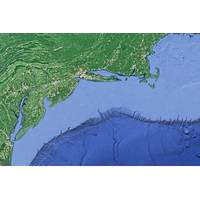
Better simulations of internal tides may benefit sonar communications, protect offshore structures, and more. In certain parts of the ocean, towering, slow-motion rollercoasters called internal tides trundle along for miles, rising and falling for hundreds of feet in the ocean’s interior while making barely a ripple at the surface. These giant, hidden swells are responsible for alternately drawing warm surface waters down to the deep ocean and pulling marine nutrients up from the abyss. Internal tides are generated in part by differences in water density…
ExxonMobil, Princeton Launch Energy Research Projects
In association with their partnership focused on energy technologies, ExxonMobil and Princeton University have selected five research projects that center on solar and battery technologies, plasma physics, Arctic sea-ice modeling, and the impact of carbon dioxide absorption on the world’s oceans. In June 2015 ExxonMobil committed $5 million over five years to the Princeton E-ffiliates Partnership, a program administered by Princeton University’s Andlinger Center for Energy and the Environment that fosters research in sustainable energy and environmental solutions.
Partnership Yields New Helical Buoyancy Technology
Diamond Offshore Drilling, Inc. and Trelleborg's offshore operation today announced a joint development agreement to develop, manufacture and market Helical Buoyancy riser technology developed by Diamond Offshore. This innovative, patented riser buoyancy design reduces riser drag and mitigates Vortex-Induced Vibration in offshore applications and enables improved operational efficiency. This solution is an alternative to adding fairings or strakes to the drilling riser and can reduce deployment time and operating expense.
BMT Delivers CFD Study for FPSO
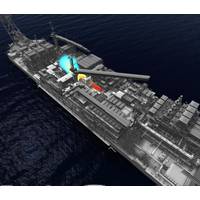
BMT Fluid Mechanics (BMT), a subsidiary of BMT Group Ltd., completed a Computational Fluid Dynamics (CFD) study for an oil major operating offshore Nigeria. BMT reports that its scope of work included an assessment of the current loading to which the FPSO hull is subjected to, which has enabled the oil major to ensure its mooring systems are fit for purpose. “CFD is becoming more commonplace in the oil and gas sector with many customers recognizing it to be an effective tool for solving challenges the industry faces in a less conservative and more efficient manner…
CFD Study Calculates FPSO Current Coefficients
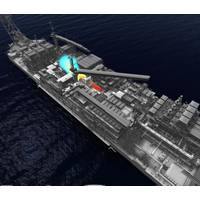
BMT Fluid Mechanics (BMT), a subsidiary of the international design, engineering and risk management consultancy BMT Group Ltd, has recently completed a Computational Fluid Dynamics (CFD) study for an oil major operating offshore Nigeria. BMT’s scope of work included an assessment of the current loading to which the FPSO hull is subjected to, which has enabled the oil major to ensure its mooring systems are fit for purpose. Johnathan Green, Manager for BMT Fluid Mechanics’ Numerical Modeling Group explained…
DNV GL Launches CFD Software JIPs
The oil and gas industry is under pressure to develop cost effective designs without compromising safety. Computational Fluid Dynamics (CFD) software is used for this purpose, but improvements are needed to help solve complex safety and design challenges in oil and gas offshore engineering. DNV GL is launching two CFD joint industry projects (JIP) to meet the industry’s need for more cost efficient and precise decision support. Both JIPs are still welcoming new participants. CFD software uses numerical analysis and algorithms to assess and solve problems involving fluid flows…
Xodus Enters Phase 2 of Pioneering Research into Multiphase Flow

Press release - International energy consultancy Xodus Group and Dutch innovation company TNO have completed the first phase of a pioneering joint industry project (JIP) into the dynamic forces which affect the integrity of piping systems, in particular through multiphase flow. The second phase of the project, which is expected to be run across three stages, is now open for new participants to join. Eight companies were involved in the first phase of the project: BP, Statoil, Total, Suncor, Shell, Lundin, Aker Solutions and FMC.
Safeguarding Against Safety Concern on FLNG Installations
Press release - Accidental release of cryogenic liquids such as liquefied natural gas (LNG) poses a significant risk to personnel and assets on oil and gas installations. In addressing these risks, Lloyd’s Register Energy has developed a guidance note that provides a consistent methodology to establish cryogenic exposure. Lloyd’s Register Energy’s newly launched guidance note provides a methodology to establish risk-based cryogenic exposure based on a probabilistic approach. It is applicable to any unit where hydrocarbon and refrigerant cryogenic hazards are relevant…
S.African Crude Blending Terminal up by 2017
New 13.2 mln barrel crude blending terminal for S.Africa; Oil majors and global oil traders sign on. Using the world's first dedicated crude oil blending terminal, South Africa will by 2017 mix different grades of crude oil for export to refineries across Asia, enabling them to produce cleaner fuels more cheaply, an official said on Thursday. Construction of the 2 billion rand ($161 million) fuel blending farm, which consists of 12 massive concrete bunkers, should start in August with the first output expected for the second quarter of 2017…
New S. African Crude Blending Terminal to Supply Asia from 2017
Using the world's first dedicated crude oil blending terminal, South Africa will by 2017 mix different grades of crude oil for export to refineries across Asia, enabling them to produce cleaner fuels more cheaply, an official said on Thursday. Construction of the 2 billion rand ($161 million) fuel blending farm, which consists of 12 massive concrete bunkers, should start in August with the first output expected for the second quarter of 2017, said Pieter Coetzee, a director at OiltankingMogs, a joint venture firm developing the terminal.
RAstar Tugs Selected Again for LNG Terminal Support
The Robert Allan Ltd. RAstar Series tugs are well proven LNG terminal support/escort tugs, in operation at major LNG facilities worldwide, including terminals in the United Kingdom, Yemen, Mexico, Indonesia, Norway, and the United States. Now Smit Lamalco has introduced five new RAstar 3400 escort tugs to the Port of Gladstone in Australia for LNG terminal support with the fifth and final vessel having just safely arrived in the Port. The five tugs SL Curtis Island, SL Quoin Island, SL Boyne Island…
Industry Addressing Offshore Pipeline Risk
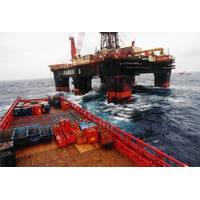
Offshore carbon dioxide (CO2) pipelines could potentially pose a risk for offshore infrastructures, ships and the marine environment. To demonstrate that CO2 pipelines can be operated safely and to ensure the risks are well understood, industry stakeholders have asked DNV GL to initiate a Joint Industry Project (JIP) “CO2 Subsea Releases - Small Scale Experimental Program’’. Several major operators have already joined the ‘Sub-CO2’ JIP including: National Grid, ENI, and Petrobras, but there is still time for others to join.
New Bulk Carrier Design Puts Ecoships in the Lotus Position
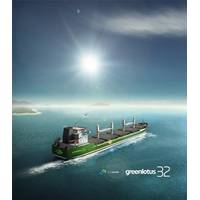
Ecoships, the technical shipmanagement arm of Newport Shipping Group, has introduced a next generation bulk carrier design, developed to set the standard in ecologically compatible marine transportation. Inspired by the low friction to water flow and self-cleaning properties of the lotus flower – a symbol of purity and beauty in Buddhist and Hindu philosophy – Ecoships’ Greenlotus 32, is a 32,500dwt geared, wide hatched, handy-size bulker, designed to meet existing and future CO2 (carbon dioxide) NOx (oxides of nitrogen) and SOx (oxides of sulphur) emissions regulations.
LR Begins OPTION Energy Consortium

Optimizing Oil Production by Novel Technology Integration (OPTION), an energy industry consortium aimed to enhance oil recovery from reservoirs, has started its mission with a kick off meeting executing its plan of action. The approximate $5.3 million project, funded by the Danish Innovations Fonden, was established by the collaboration of Lloyd’s Register (LR) Energy, LR Senergy, the Technical University of Denmark (DTU) and Welltec. Sixteen members of the project group met in Denmark to develop a strategy…
US Navy Seeks to Transform Gas Turbine Technology
Naval Research Laboritory (NRL) scientists study the complex physics of Rotating Detonation Engines (RDE's). With its strong dependence on gas-turbine engines for propulsion, the U.S. Navy is always looking for ways to improve the fuel consumption of these engines. At the Naval Research Laboratory (NRL), scientists are studying the complex physics of Rotating Detonation Engines (RDEs) which offer the potential for high dollar savings by way of reduced fuel consumption in gas-turbine engines, explains Dr. Kazhikathra Kailasanath, who heads NRL's Laboratories for Computational Physics and Fluid Dynamics.
